
Abstract wall sculpture. Wood, plaster, sand, acrylic. 52x38x5cm. August 2025
Formation
An abstract wall-mounted sculpture composed of plaster hemispheres on board, painted with sand and acrylic paint.
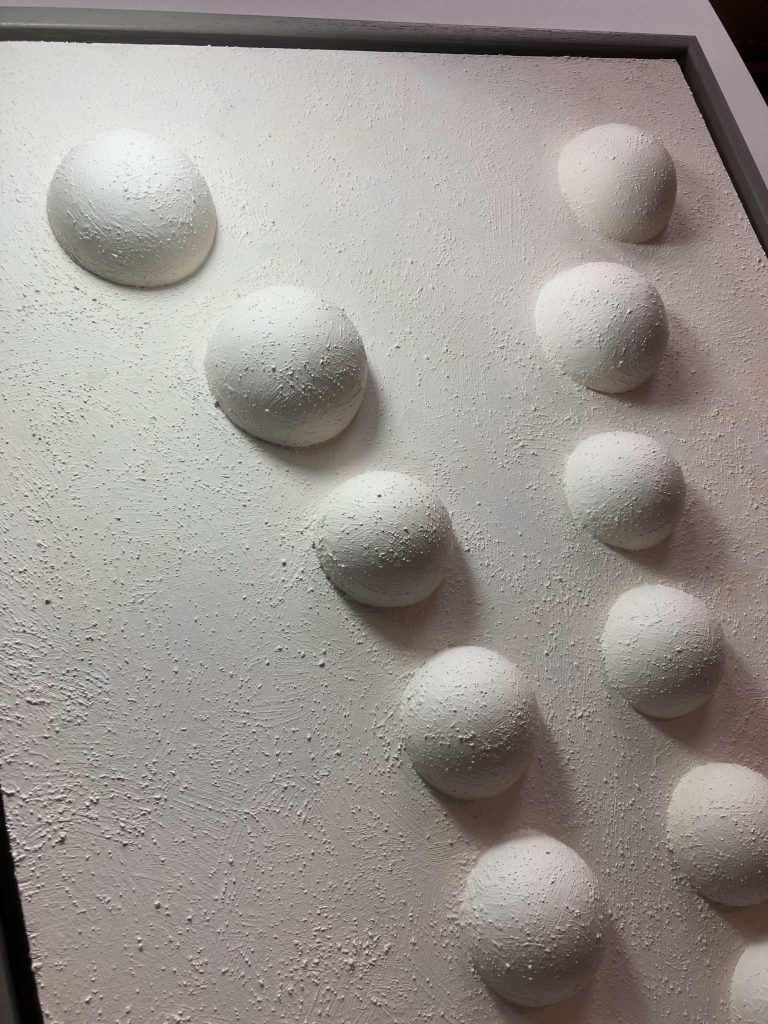
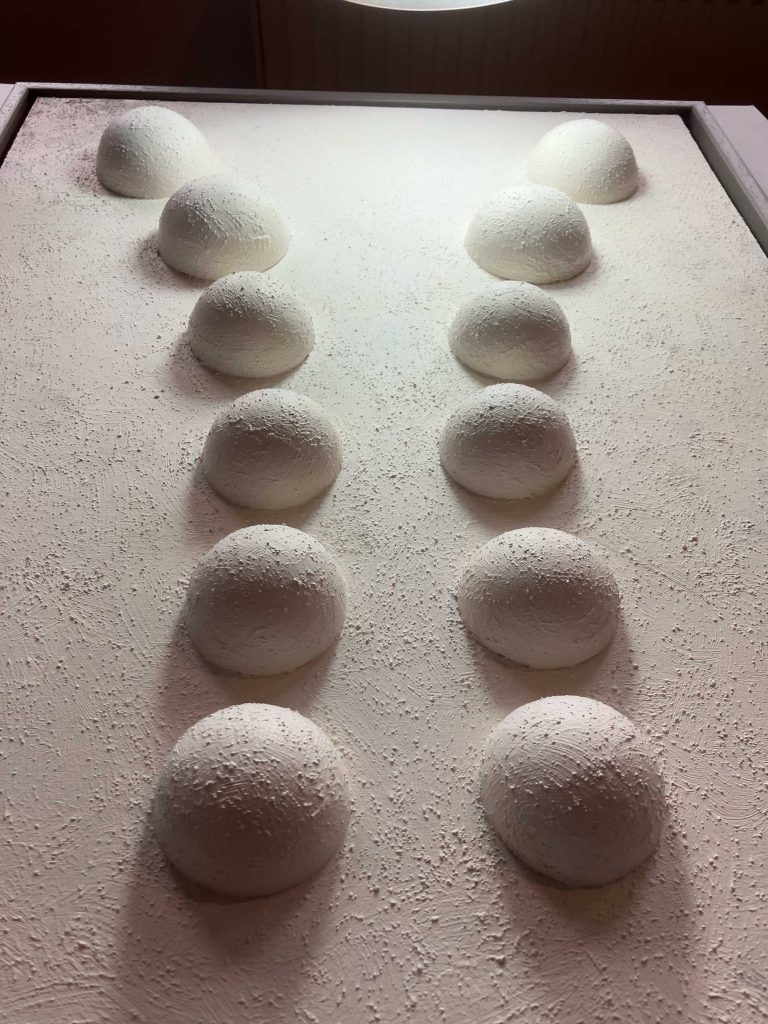

An abstract wall-mounted sculpture composed of plaster hemispheres on board, painted with sand and acrylic paint.


post content
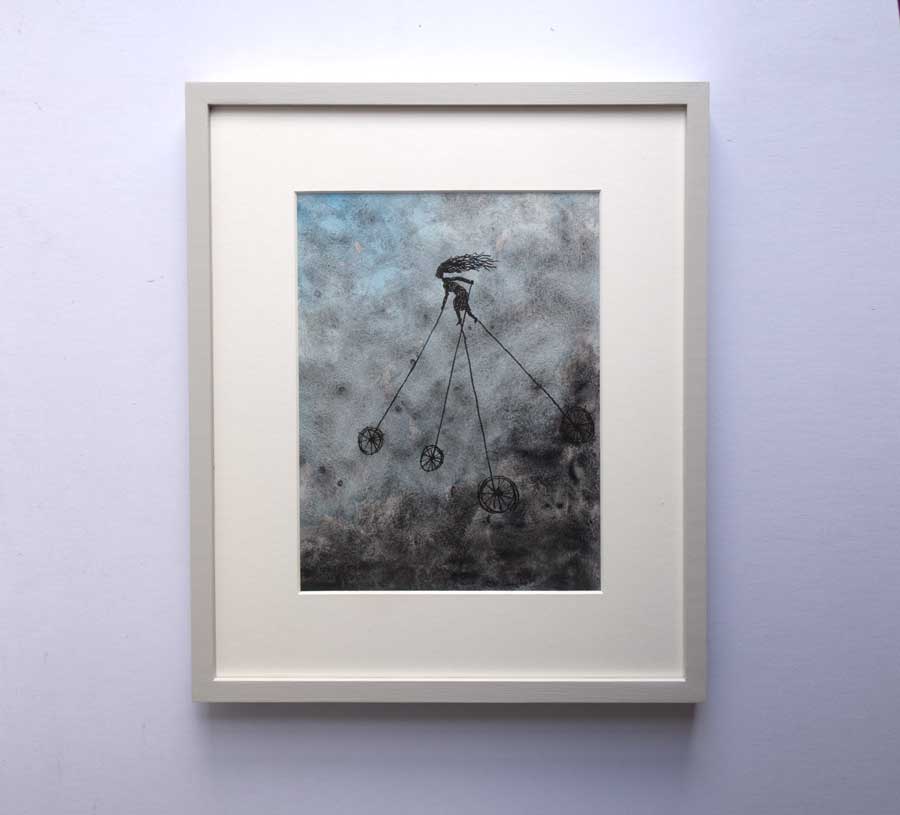
A pen and ink drawing of a woman walking on stilts that have wheels to help them to move along. The woman seems to be walking in the air for some reason. I’m not quite sure how the does it.
The pen and ink drawing is done on a sheet of paper to which a watercolour wash has been applied. The wash was applied in several layers, the first of which was composed of Daniel Smith Lunar Black watercolour which was specifically chosen because it can create pronounced granulation effects, as shown in the images below.
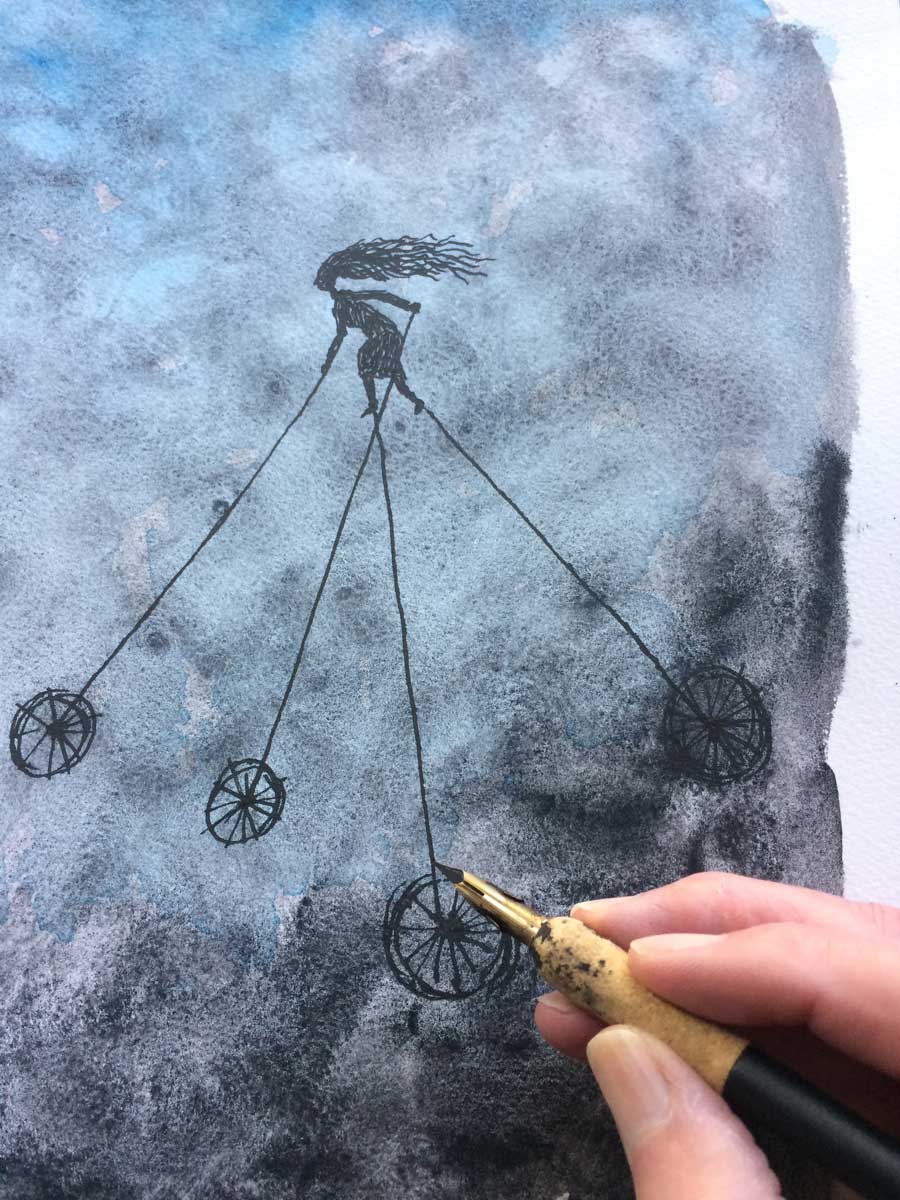
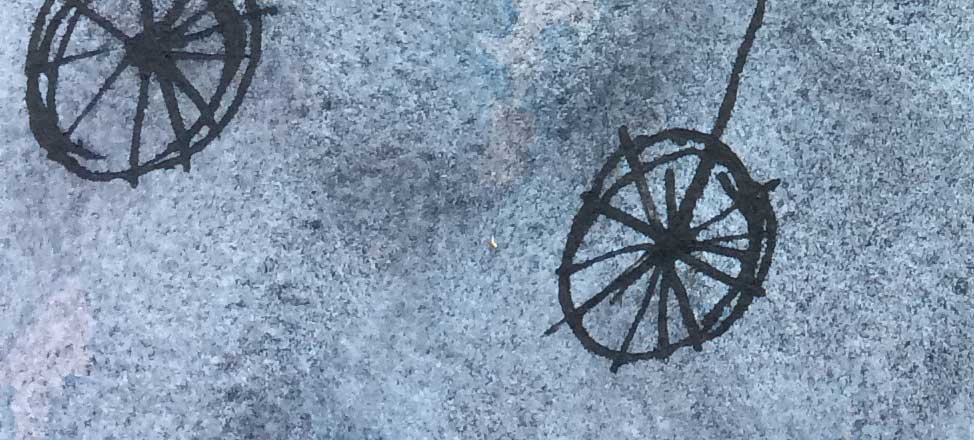
post content
A sculpture created from two hammerheads, two ball bearings, six wooden hemispheres and length of card. The parts are held together by magnets.
The central components of this work are two hammerheads – artefacts that have been recurring features of my work for many years, usually in the form of drawings and more recently in the form of small scale sculptural work, The hammerheads are usually, but not always, used to represent the heads of people or animals.
…….
post content
Hemisphere sculpture.
A close-up of the surface of an artwork from my series featuring protruding and recessed hemispheres in flat surfaces.
This particular artwork is a wall hung sculpture filmed while lying horizontally. The interesting light effects are created by sunlight passing through trees. The texture of the artwork is created by mixing sand with gesso.
post content
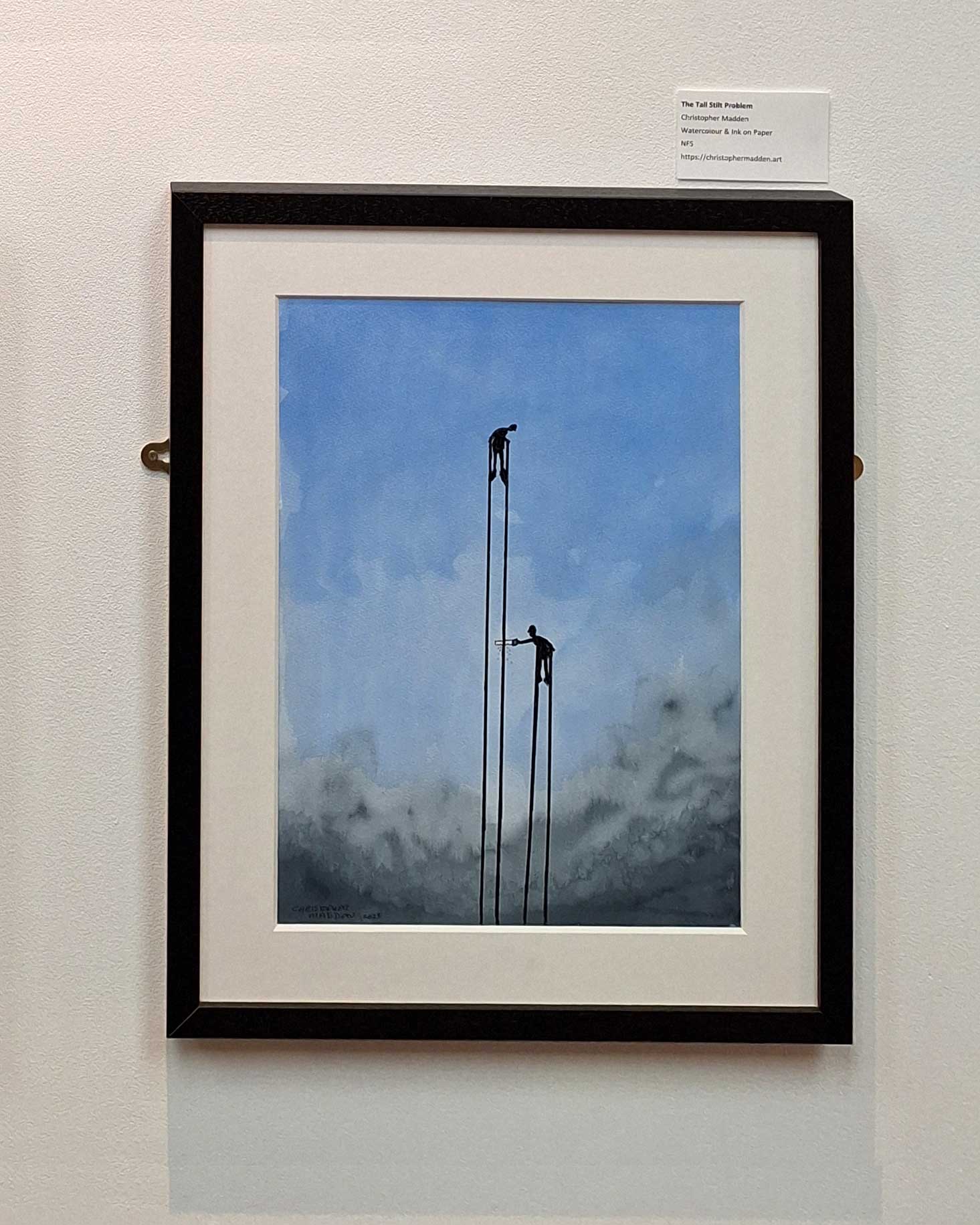
Exhibited in Shrewsbury Museum and Art Gallery, July – August 2025
The painting depicts one of the aspects of power relationships.
It shows two people on stilts – one on tall stilts and one on shorter stilts. The tall stilts symbolise greater power. The person on the shorter stilts is sawing through one of the tall stilts. This symbolises the deposing of the powerful person on the tall stilts. Significantly, it is the fact that the stilts are so tall that makes them vulnerable to being sabotaged.
The work can be seen as a metaphor for one of the relationships between the powerful and the less powerful.
It’s also quite funny.
post content
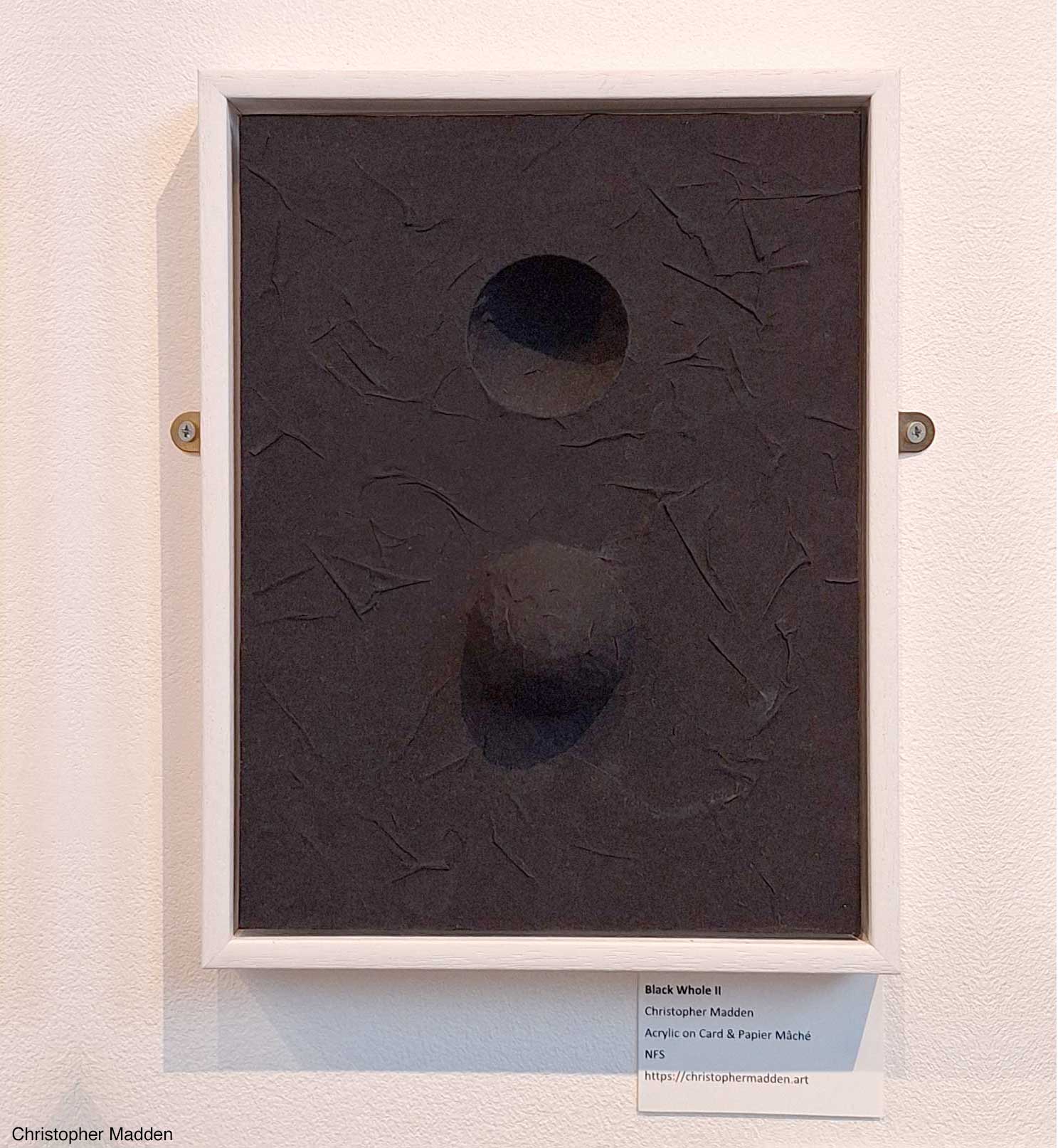
Exhibited at Shrewsbury Museum and Art Gallery, July and August 2025.
A work in my Black Whole series.
The works feature a hemispherical form protruding from the plane of the work and an equal and opposite hemispherical form receding into it.
The work was concieved partly as a visualisation of the positive and negative forces that underlie the physical structure of the universe. The concept is that at the most fundamental level of physical reality nothing exists except what can be thought of metaphorically as a flat featureless plane or surface. This featureless plane represents the existence of “nothingness” and is represented in the artwork by the flat surface of the work. A single disturbance to this plane creates a paired bulge and depression (just as a single wave creates a peak and a trough), represented in the work by the raised hemisphere and the recessed hemisphere.
The bulge and the depression are equal and opposite, so they can be thought of as cancelling each other out. As a result they add nothing to the “energy” at this fundamental level of reality. The fundamental plane is still. on average, flat. So, although something exists (in the form of the bulge and the depression), on average nothing still exists. The creation of ‘something’ does not alter the existence of nothing.
Nothing exists.
The work is painted very matt black to allude to the existence of nothing.
post content
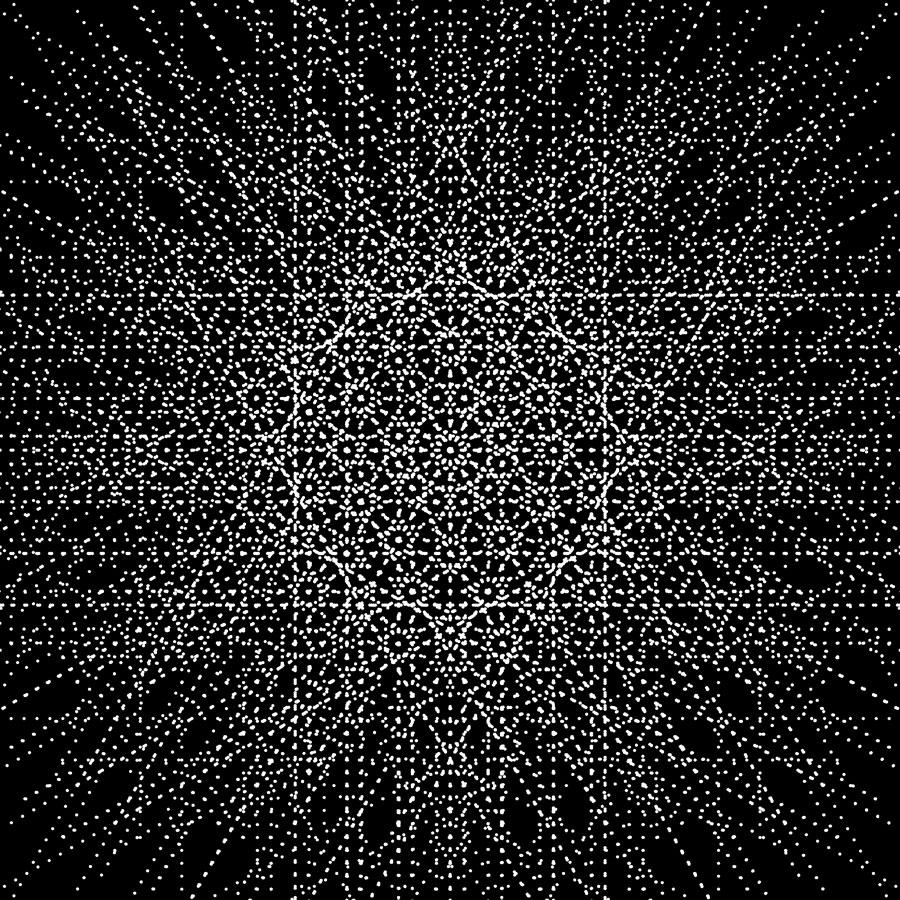
This image is composed of multiple identical rows of dots with the rows arranged at regular angles to each other and with regular spacing. An animation showing the positioning of the rows of dots can be seen here.
The circles in the image are formed as the result of the interaction between the separate rows of dots. There are no circles in the underlying components of the image. An idea of the underlying rows of dots in the image can be found by looking at the corners of the image where the number of rows is fewer.
I’ve produced several images of this type over the years since about 2017.
The work is linked to my interest in the scientific principles concerning the generation of complexity in the universe from simpler forms. Ultimately this involves trying to comprehend the generation of the most basic entities in the universe from something that’s just one step removed from nothing. It’s about the generation of something from nothing.
post content
This is an animation of a work that I created in 2017.
It starts with a of a row of dots which are repeated and rotated to form a star shape. This shape is then repeated and repositioned in specific locations relative to the original star shape. The resulting patterns are then repeated and repositioned in the same way.
The pattern generated by the positions of all of the repeated dots that were in the original straight line contains multiple overlapping and interacting circles.
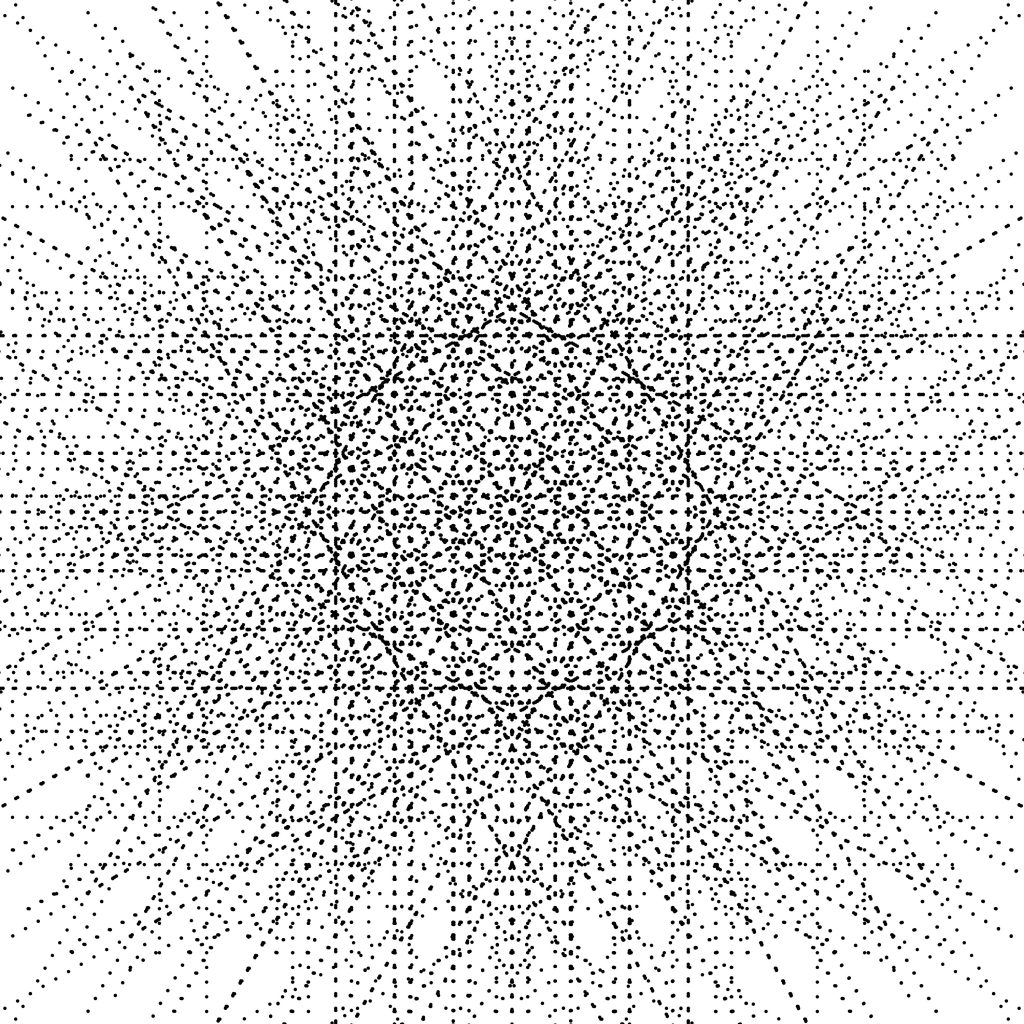
post content
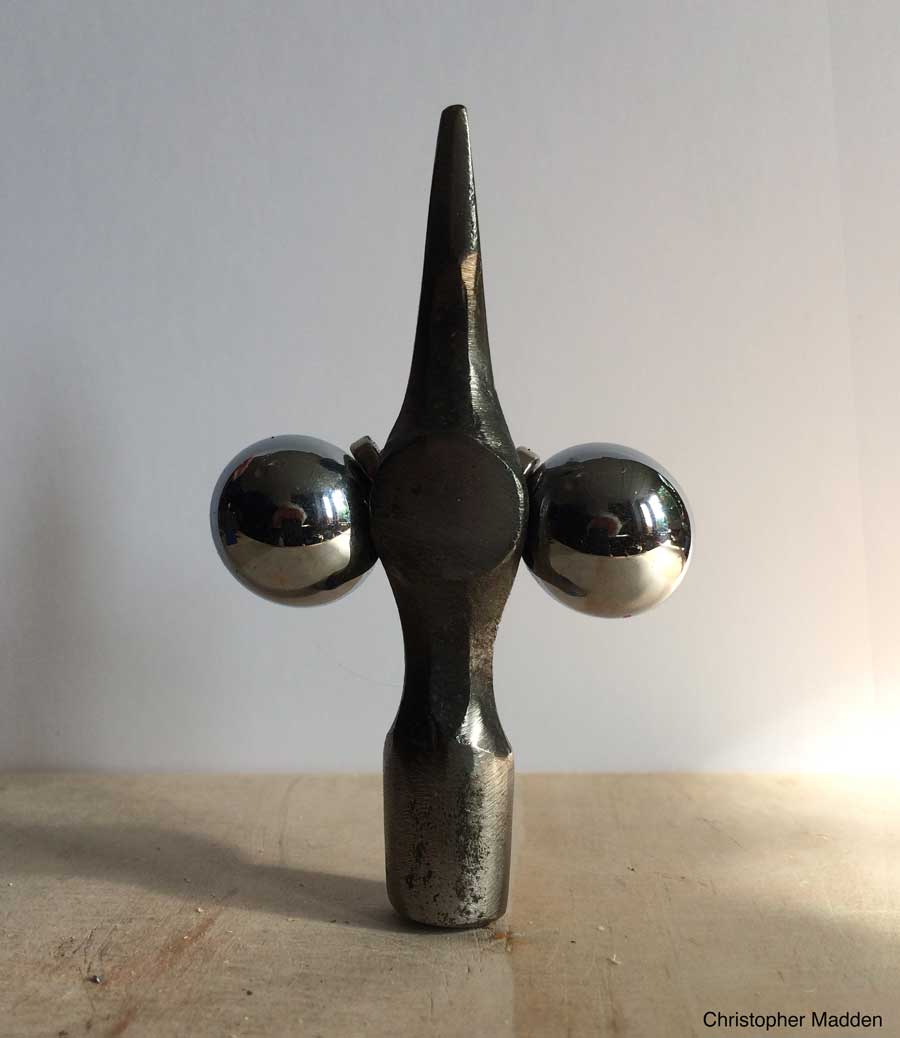
A sculpture composed of the head of a cross pein hammer with two steel spheres attached to its sides.
Hammerheads standing on end have an interesting anthropomorphic quality to them. This anthropomorphism is exploited in this work to create an ambiguous form.
The work possibly suggests a human figure with spheres in the place of arms. Or it could suggest the head of a creature such as an insect with the spheres as huge eyes.
The steel spheres are attached to the hammerhead by magnets.
post content
A work from my Complexity series studying the generation of complex forms from simple forms.
Identical simple grids of dots are superimposed and rotated relative to each other. The grid for this piece is shown below.
Simple algorithms dictate how the superimposed grids interact with each other. For instance where the same colours on each grid are superimposed on each other they cancel out to generate white and where complementary colours are superimposed they generate black.
The genesis of this series was my attempt to find a visual metaphor for the creation of the complexity of the universe from an almost absurdly simple starting point.
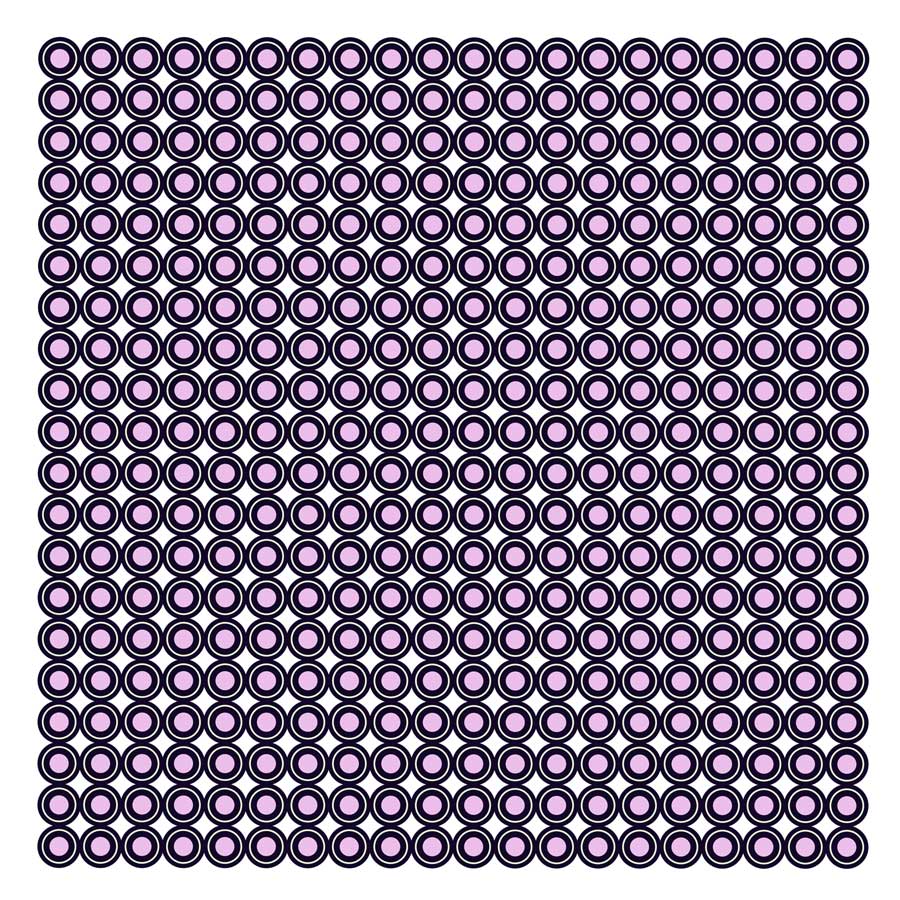
post content

A visualisation of a proposal for a mural painted directly onto an art gallery wall.
The mural depicts a procession of people with extremely long legs.
A possible interpretation of the work is that the extreme height that the people have attained due to having such long legs comes at a price.
Physical height is usually thought of as being desirable in people as it is interpreted as a sign of power and strength.
However it has its drawbacks. Tall people tend not to live as long as shorter people, and in the case of the long-legged people in my image how on earth do they tie their shoe laces? Also, notice that they seem to need sticks to help them to keep their balance.
The physical height of the people can be taken to be a metaphor for power of more abstract forms, while the sticks that the people are using in order to keep themselves upright may be seen as metaphors for the methods which people in positions of power have to use in order to prop themselves up.
The mural in this montage was drawn on an iPad.
post content
A sculpture of assemblage composed of blocks of wood and rusty nails salvaged from an old builder’s pallet.
An example of up cycling in contemporary art.
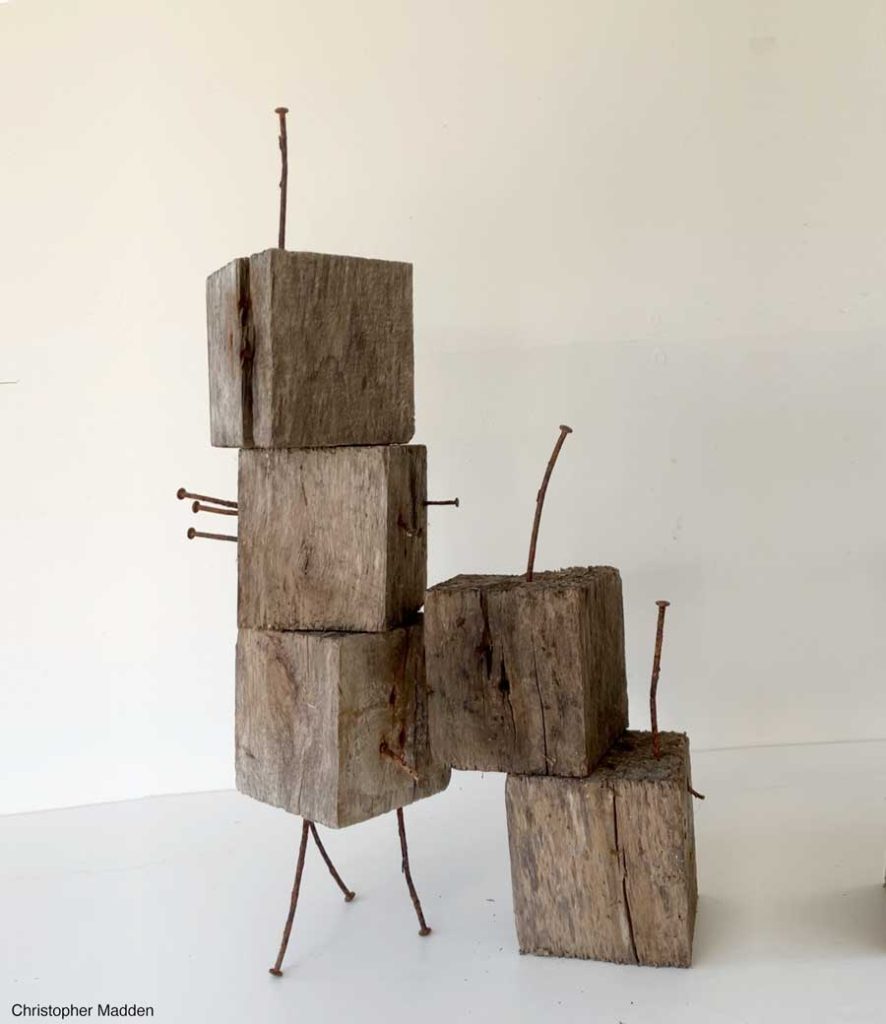
post content
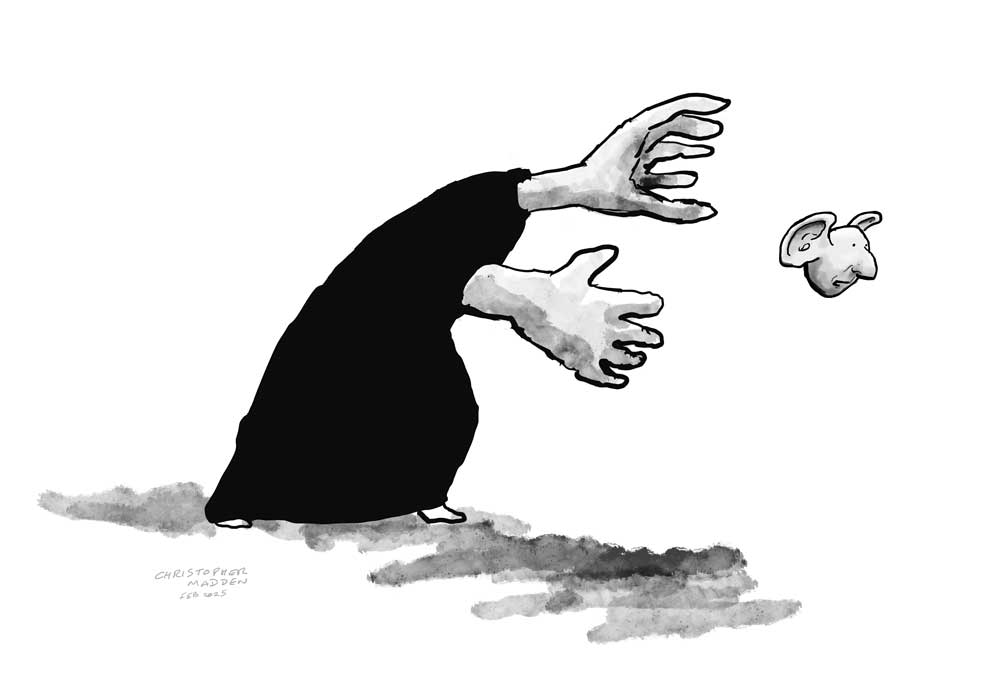
A digital sketch from the imagination, drawn on an iPad.
This sketch was drawn spontaneously, with no preconceived idea of what I was going to draw.
It’s quite bizarre and fantastical, maybe a bit unsettling and grotesque.
The process involved drawing the slightly random black form of the body first and then adding additional elements that were suggested by the shape of the body. The giant hands were the first additions. These suggested that the figure should remain headless.
The hands seemed to be grasping for something, which suggested a floating object just out of reach of the hands. This in turn suggested that a floating head could be the object, particularly because the figure had no head.
This in turn gave rise to the idea that the head could actually be flying, and that it could be doing so with the use of extra-large ears (possibly reflecting the extra-large hands of the headless figure).
post content
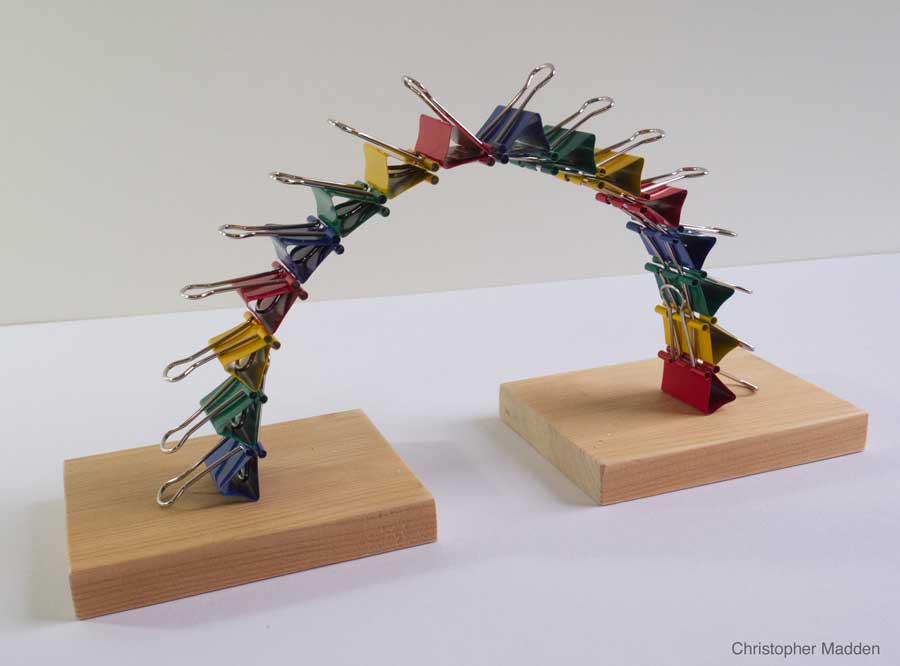
A sculpture composed of document clips that grip each other to form an arch or bridge. The bridge spans the gap between two pieces of wood on which the document clips stands.
Part of the concept behind the assemblage is that the arch of clips literally bridges the gap between the two separate parts of the base. The linked clips represent the concept of achievements that can only be made by cooperation with others (In this case with other document clips). It’s a metaphor for communication and cooperation.
The fact that the clips are in a variety of different colours is significant, as it represents diverse types of people cooperating. The colours aren’t meant to signify any particular quality of diversity such as race or sexuality, just diversity in general.
It’s quite a literal sculpture, conveying a straightforward concept. It’s also a simple and elegant form. Simple in form and simple in concept – that makes a change.
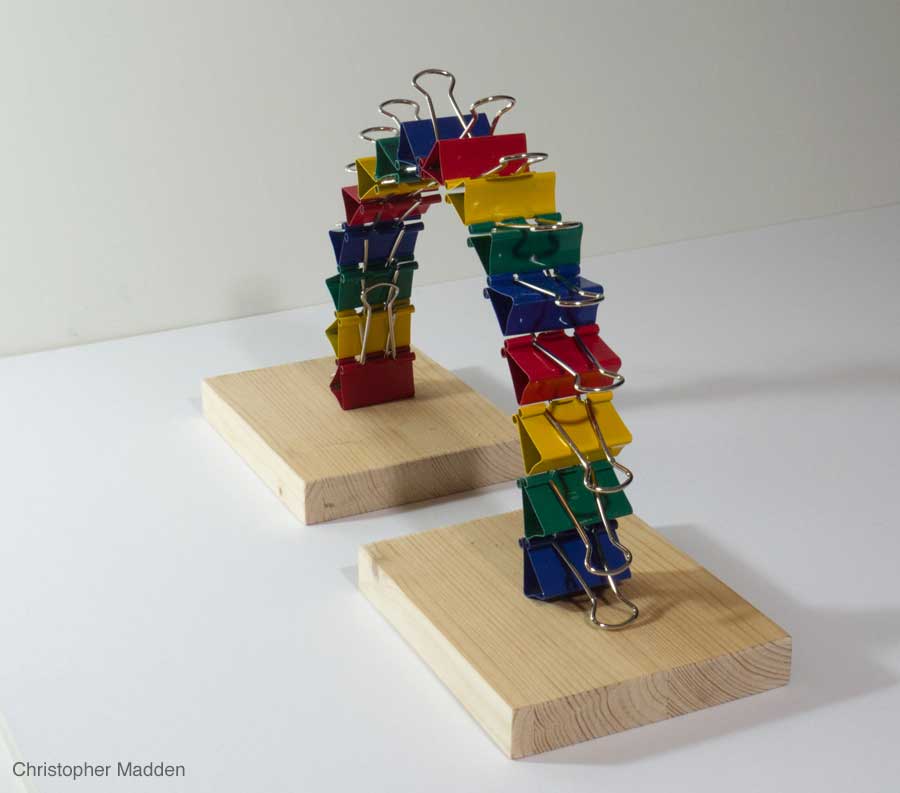
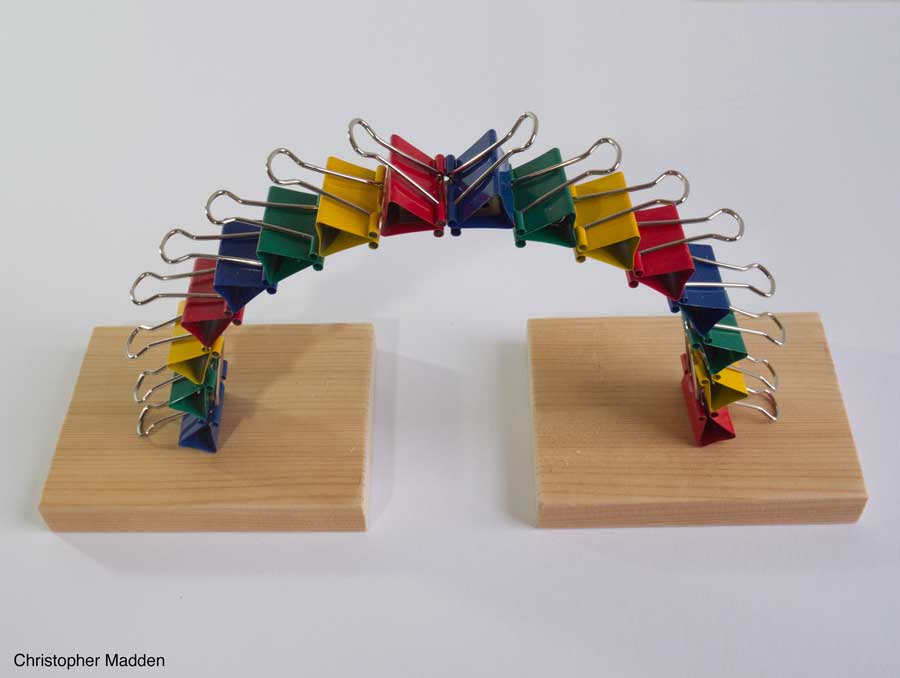
post content
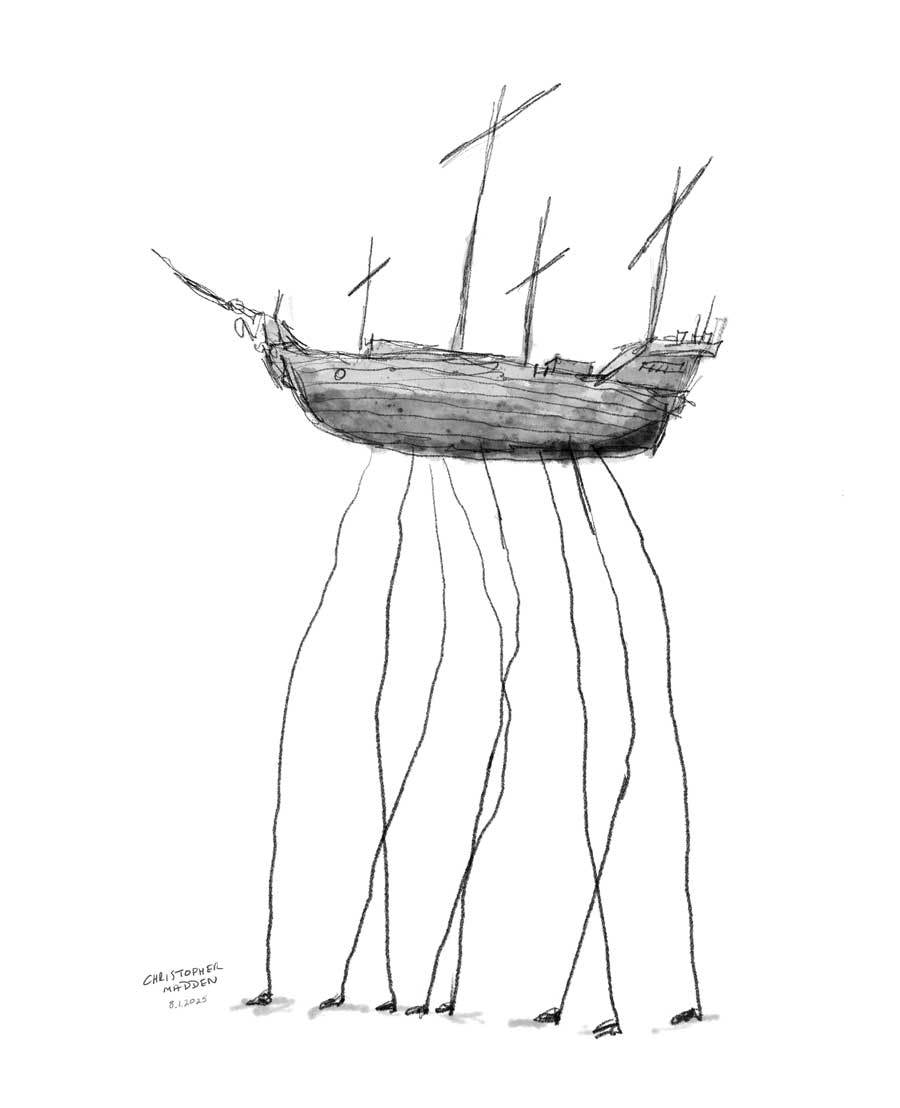
A sketch from the imagination depicting a ship with legs.
The ship looks as though it may be based on a historical wooden sailing ship. The masts resemble crosses for some reason, each having only one horizontal member (or yard). This is probably just for simplification and clarity (and laziness) rather than it being some sort of profound allusion to Christianity. Feel free to find a profound allusion though. The legs are very long and spindly, which is probably linked to the long-legged surreal birds that I’ve drawn on and off over the years, starting about fifty years ago in the 1970s.
The sketch was drawn on an iPad in Procreate. I see from the metadata that it’s got 318 strokes and it took 12 minutes.
post content
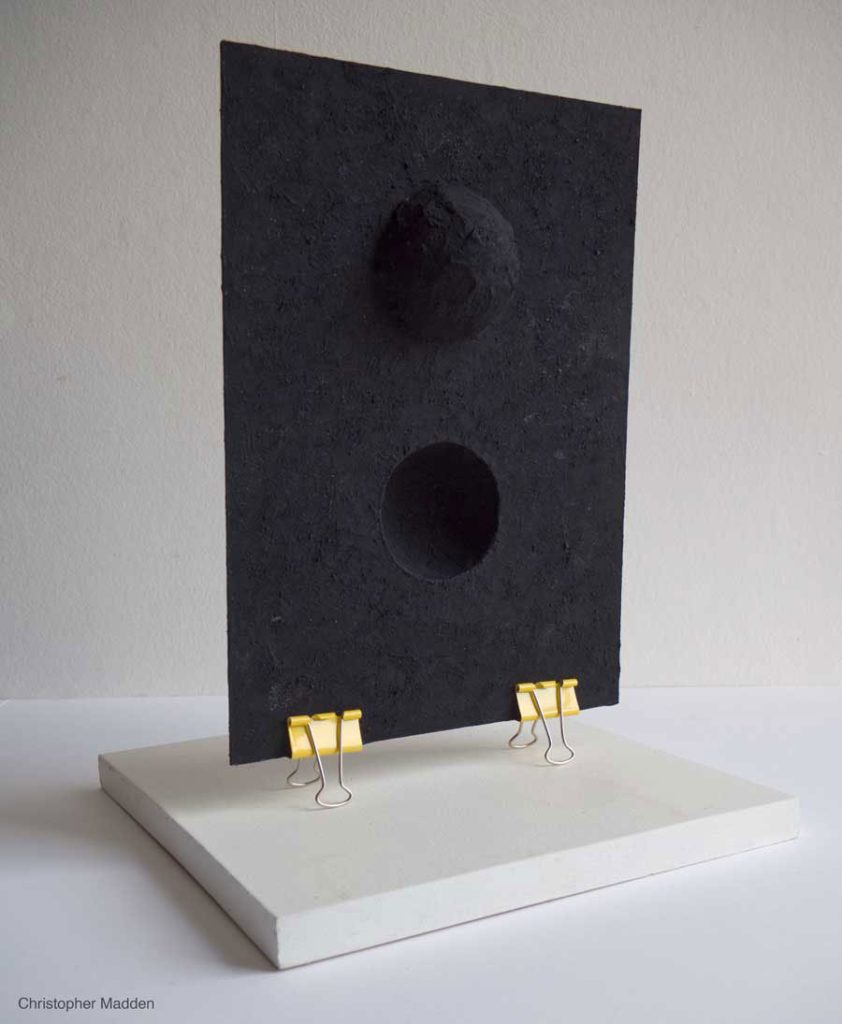
This work was displayed in the Royal West of England Academy, Bristol exhibition Paper Works, 2025.
A sculpture composed of two hemispheres on a flat surface, with one of the hemispheres protruding from one surface and the other protruding from the other surface. Both hemispheres are hollow, so that relative to each surface of the flat card one hemisphere protrudes and the other creates a hollow. The sculpture is coated with very matt black acrylic paint (Stuart Semple Black 4).
The matt black colour of the sculpture makes the form deliberately difficult to read. This is especially the case with the hollows (possibly because the brain is not expecting there to be hollows in the surface).
On one level the work can be viewed as a simple intriguing puzzle that engages the viewer’s perception and cognition in interpreting the positive and negative forms that are generated by the hemispheres.
The work also has a metaphorical interpretation that relates to my interest in science.
In this interpretation the flat black surface of the sculpture can be thought of as representing the ‘base state’ of physical reality. Think of this state as being flat and featureless – a state in which nothing physical can meaningfully be said to actually exist – maybe the ‘resting’ state of the universe. Perhaps think of it as being comparable to a graph in which the line of the graph flatlines along the zero value of the x axis, indicating that there’s nothing to measure.
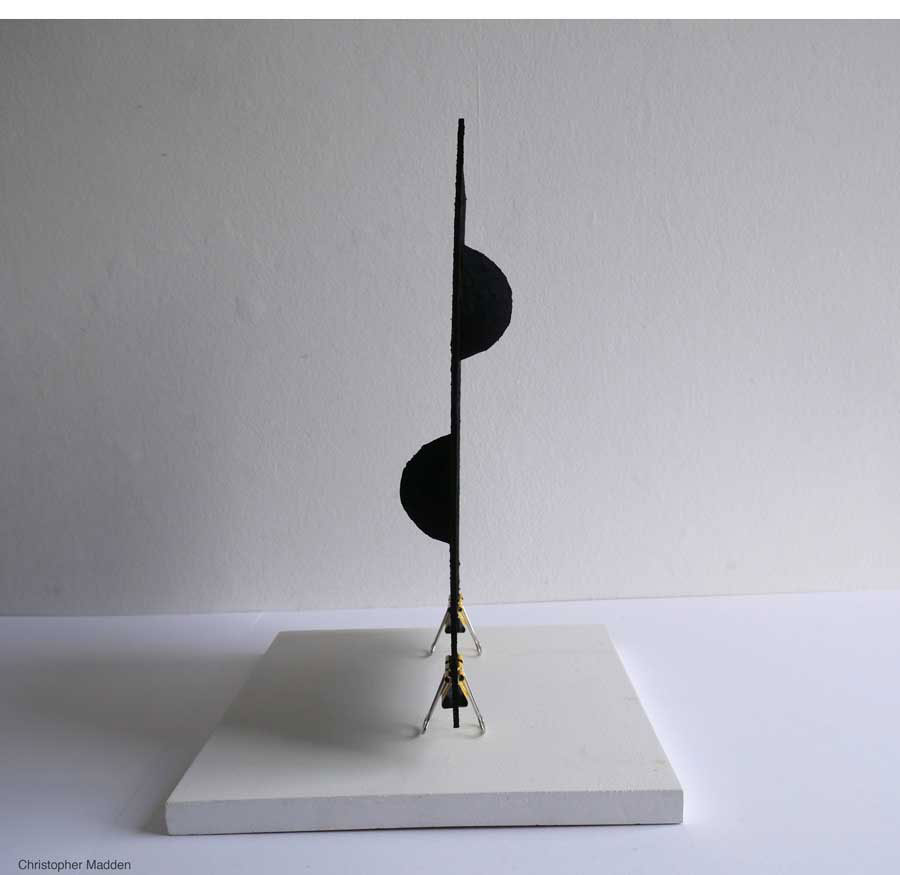
The two hemispheres in the sculpture disrupt the flat surface, creating the existence of form. Returning to the graph analogy, this is similar to the presence of two blips on the flatlining graph, with one blip going up and the other going down.
Because the hemispheres are hollow the pair create a bulge and a depression on each side of the flat surface, with the one that forms a bulge on one side of the sculpture forming a depression on the other side.
On either of the two sides of the flat surface, in terms of total volume, the bulge of one of the hemispheres and the depression of the other cancel each other out, with the negative volume of the depressed hemisphere cancelling the positive volume of the protruding one.
This can be thought of as an analogy for the physical nature of the universe at its most fundamental level. The flat featureless surface of the sculpture represents the flat featureless ‘surface’ of the fundamental universe when it is devoid of matter and when nothing exists other than the ‘surface’. The pair of hemispheres conceptually represents a single fundamental ‘disturbance’ in the flat fearless surface, a single simplest element of existence perhaps analogous to the most fundamental of fundamental particles.
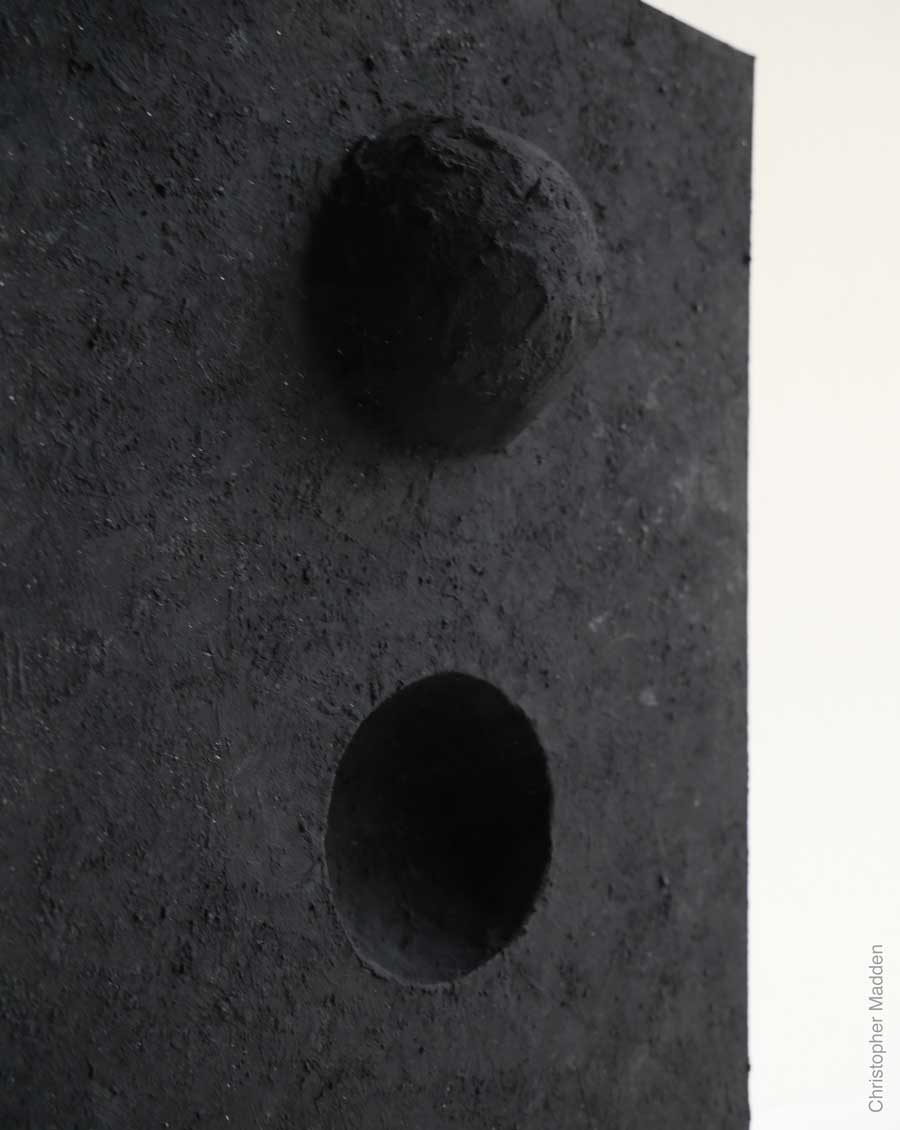
Importantly, because this fundamental disturbance is represented by two identical forms (the hemispheres) of which one has positive volume and one has negative volume which cancel out, the total volume of the disturbance is zero. This is analogous to the physical universe arising out of a state of nothingness (the flat surface) yet adding nothing to the volume, thus adding nothing to nothing.
So, although the universe exists it is still composed of nothing.
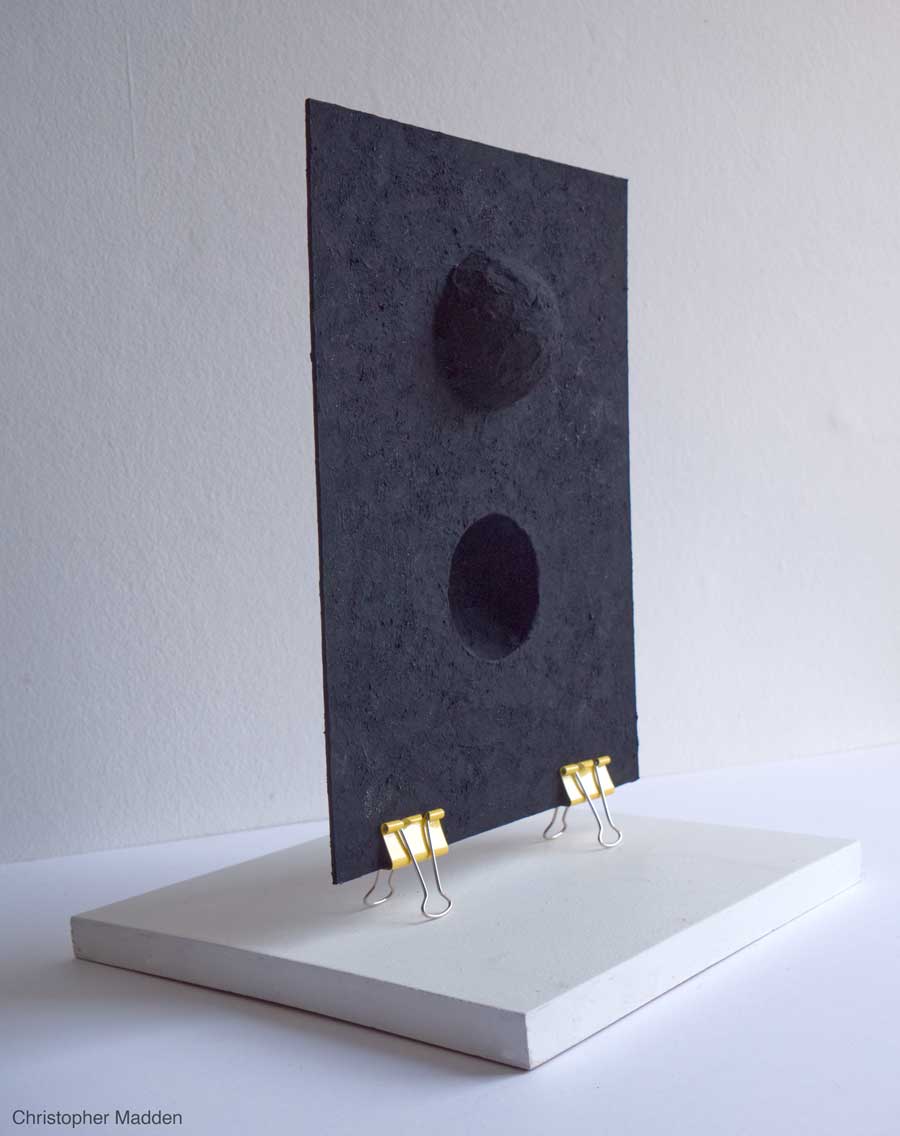
This work reflects my interest in both art and science (I started out on a scientific career before moving over to an artistic one).
I believe that art and science are often much more closely linked than is often assumed. There is for instance a huge amount of aesthetics in the appreciation of mathematics, and the study of the way that our senses make sense of the world is nothing if not a science.
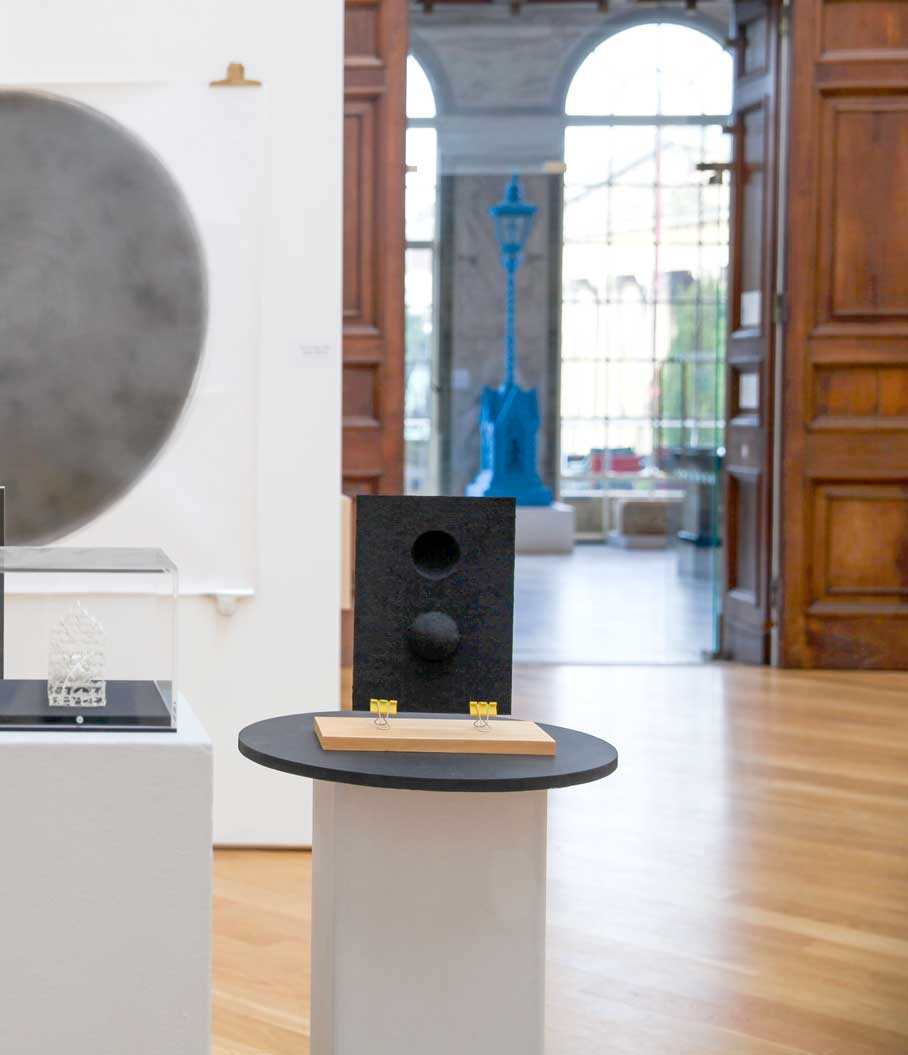
post content
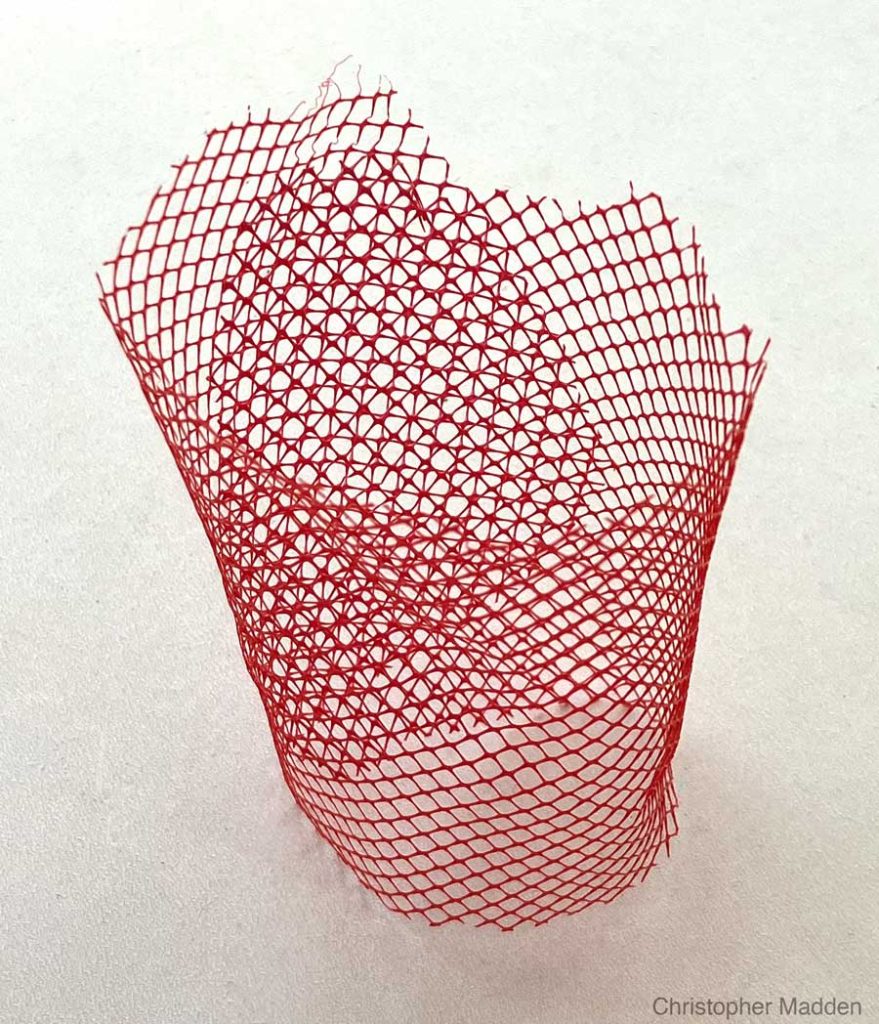
The work consists of a sheet of plastic mesh from the packaging for a pack of oranges.
I particularly like this piece because of the mundanity of its material.
I’ve been experimenting with the generation of moiré patterns and related optical effects for many years, often involving the interaction of digitally generated simple grids such as in the example below from 2008 or as seen here .
I’ve previously used the same sort of plastic mesh to create moiré patterns in an exhibit in my solo exhibition at Tremenheere Sculpture Gardens in 2022.
The term moiré pattern or moiré fringe comes from a type of French fabric called moire, in which two layers of fabric are pressed together to form a single sheet in which the slight misallignment of the fabric’s mesh generates patterns.
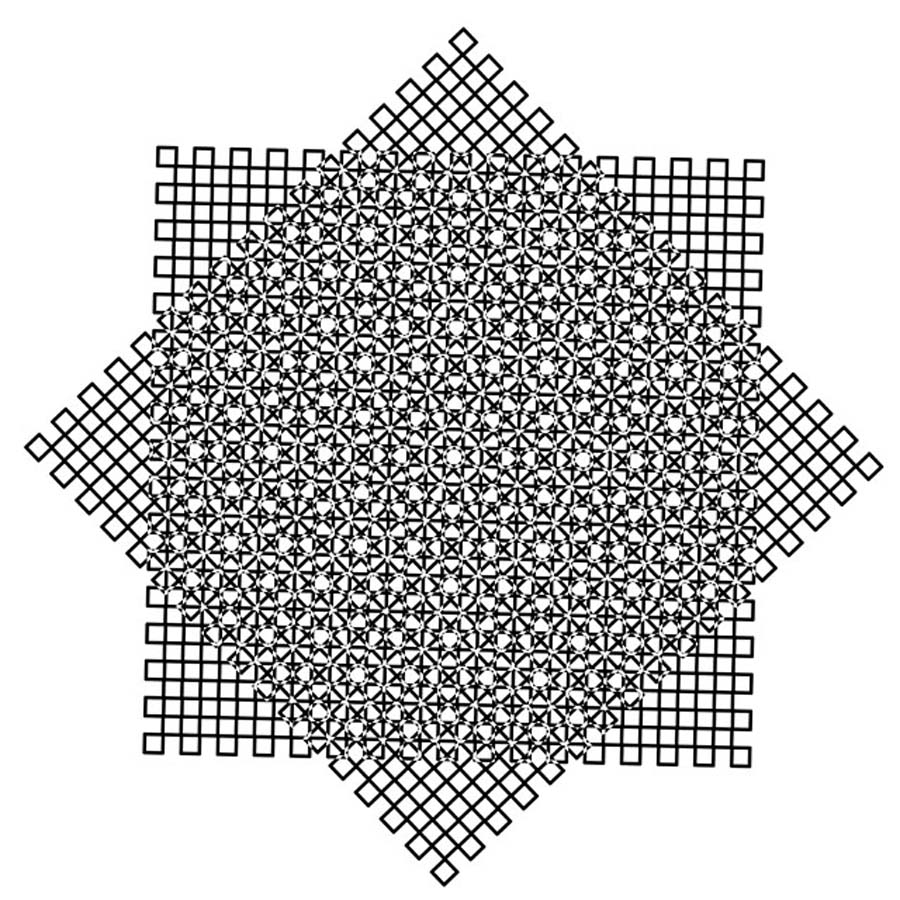
post content
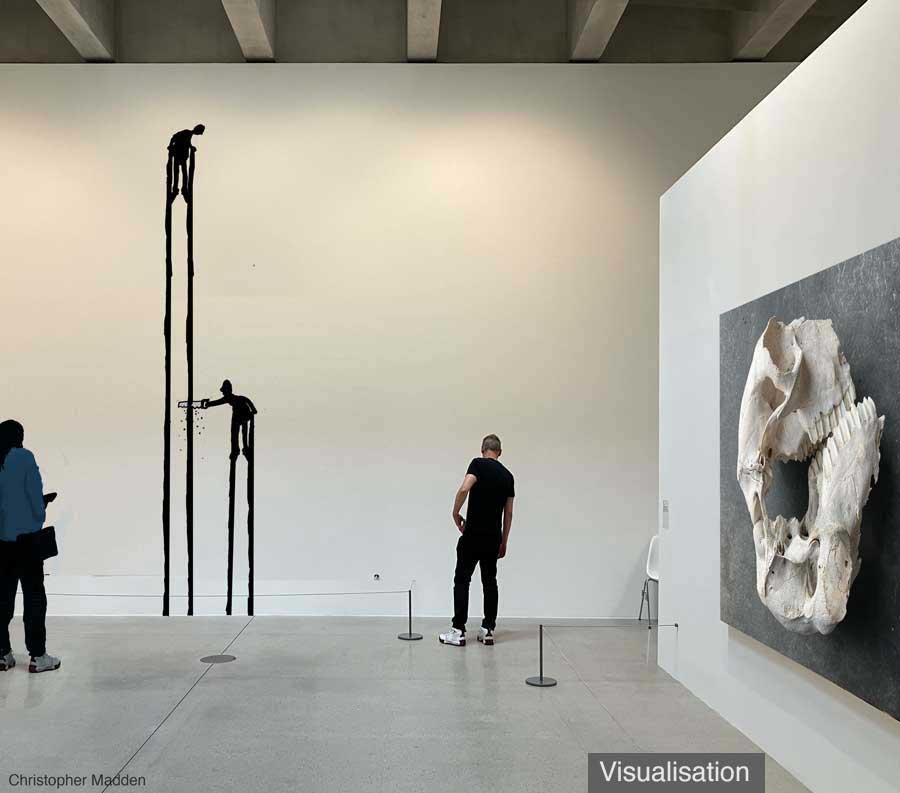
A digital visualisation of a proposed mural on an art gallery wall.
The mural depicts two men standing on stilts. One of the men has much taller stilts than the other man. The man with the shorter stilts is sawing through one of the tall stilts.
The image is partly a metaphor for power and attacks on that power. It’s also just a funny idea.
The image can be interpreted as a metaphor for political power and opposition to that power. The person on the tall stilts is invested with the power while the person with the short stilts is wanting to topple the person in the position of power (as an act of rebellion against political oppression, military repression, economic exploitation or one of any number of engines of social or political inequality).
The power that is personified in the image needn’t necessarily be the power of large scale institutions and entities, but could also be the power gained at an interpersonal level by an individual who has status enhancing qualities such as an appealing personality or striking good looks, making the attacks on that individual the consequence of personal envy or resentment.
The man on the tall stilts represents a person in a position of high status or power. The structure of that power (the tall stilts) however makes him isolated from people with less power (the shorter stilts). This flaw makes him vulnerable to attacks from below, especially if the person below has a metaphorical saw.
I’ve used a cartoon-like quality for the image is because the cartoon medium is the perfect way to convey the concept in the image. I think that cartoons are an excellent medium for political or social comment art as they can convey concepts directly and unambiguously. I’ve drawn cartoons for publication in newspapers, magazines and books since the 1970s. You can see my cartoons here.
The large photograph on the wall in the visualisation is from a series of studies of skulls.
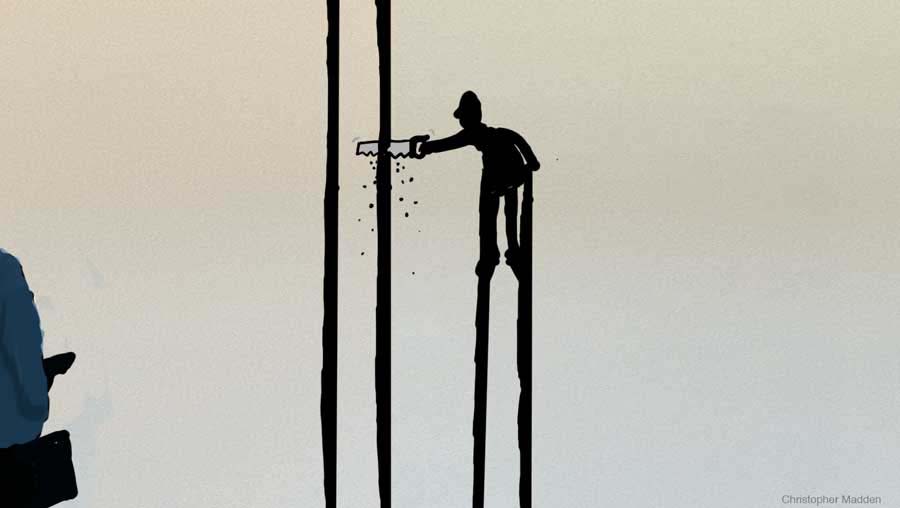
post content
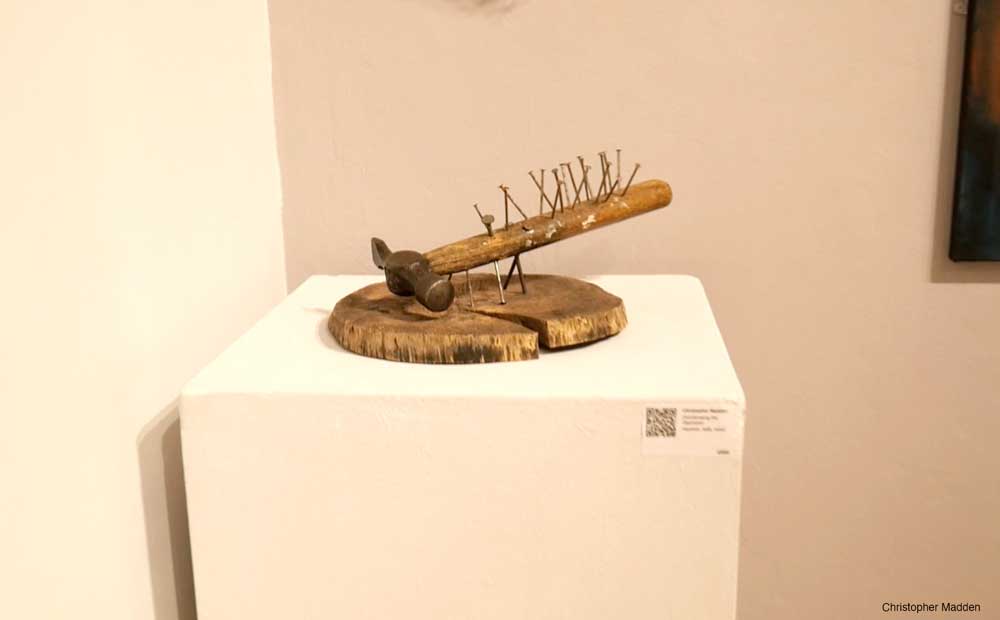
Shown in the ING Discerning Eye exhibition in the Mall Galleries, London, November 2024.
This sculpture, composed of a hammer and nails, symbolises the act of the oppressed overthrowing their oppressor. The nails represent the oppressed and the hammer represents their oppressor.
The metaphor raises a few questions . How did the nails become driven into the hammer? By another hammer? If so, is that other hammer a potential oppressor? Is the (unseen) second hammer just an oppressor in its own right, simply using the nails for its own ends?
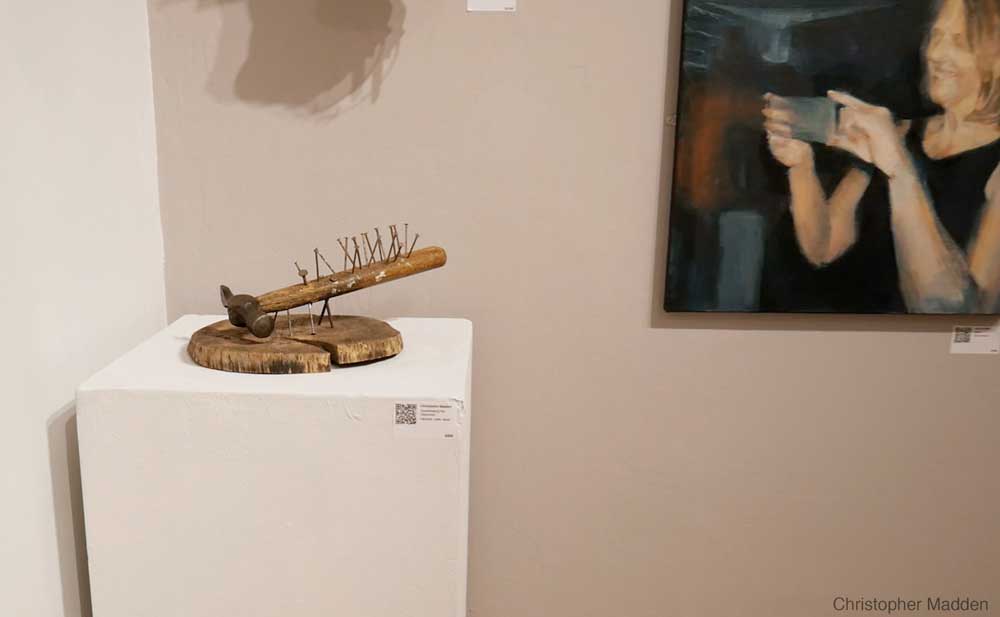
post content
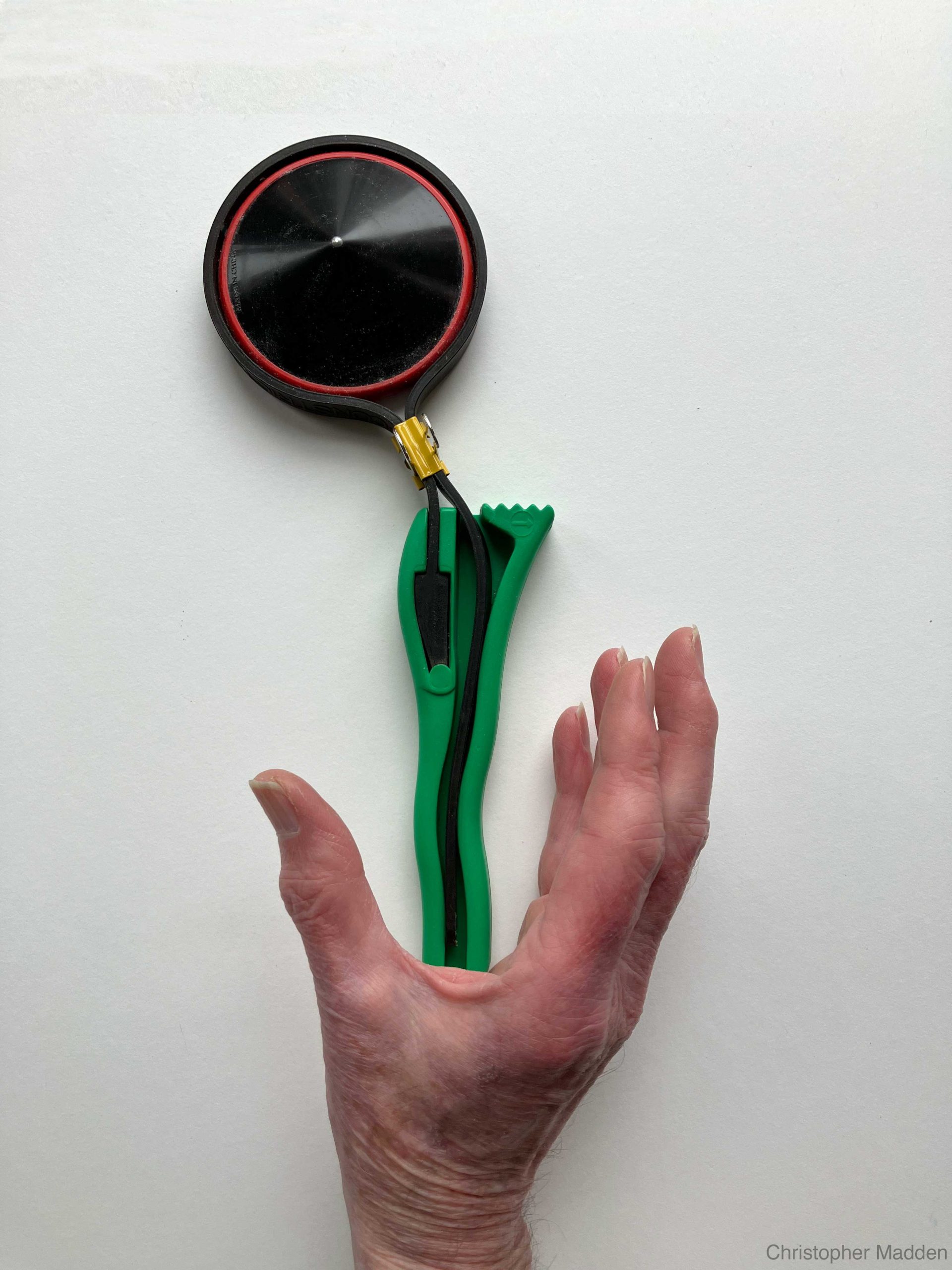
An assemblage of household items (a jar opener, a spinning top and a document clip). In the photograph the assemblage is paired with a human hand to create an ambiguous form. There are suggestions of a flowering plant, a human form or an apparatus with a wheel.
post content